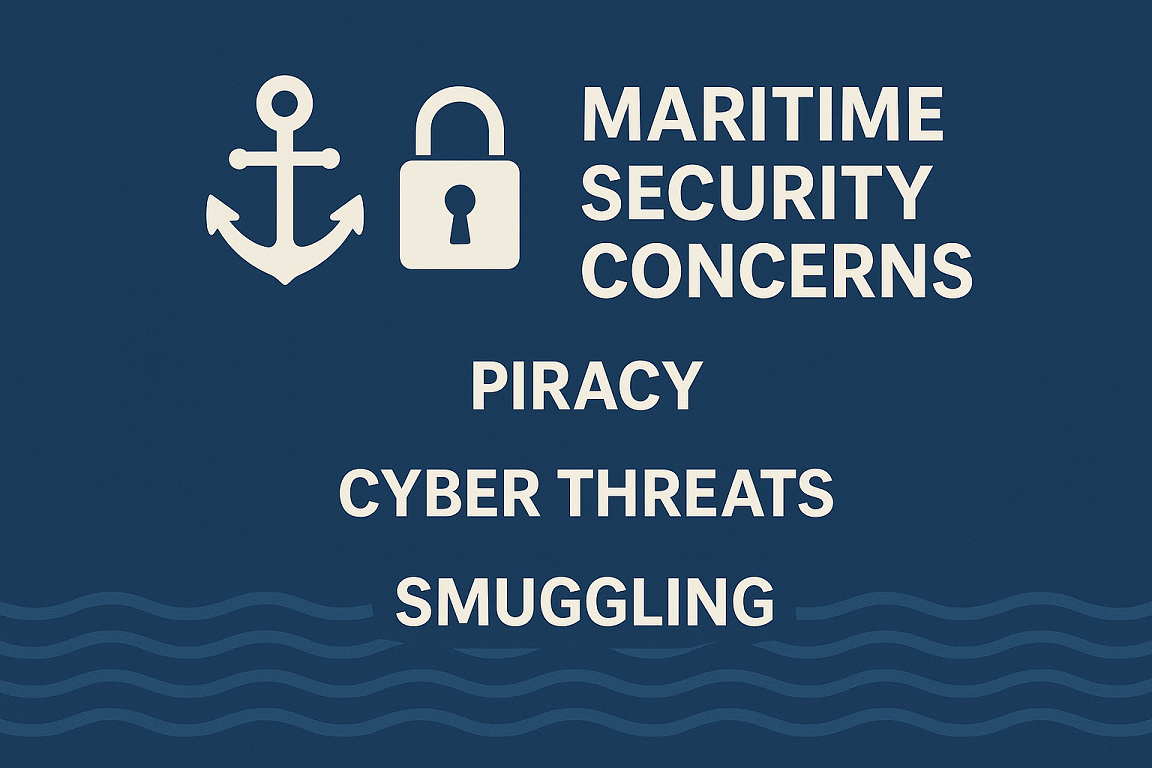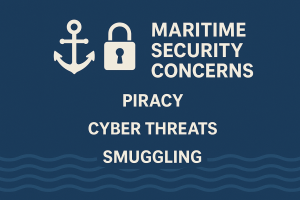Explore the growing maritime security concerns affecting global trade and navigation, including piracy, terrorism, cyber threats, and geopolitical conflicts. A must-read for maritime students, professionals, and industry leaders.
⚓🔐 Are Our Oceans Really Safe?
Did you know that over 90% of the world’s trade travels by sea? Yet, beneath the waves and between busy shipping lanes, maritime security threats are on the rise—from piracy off the Horn of Africa to cyberattacks on port systems and missile strikes in the Red Sea.
Whether you’re a shipping company, student, policymaker, or maritime enthusiast, understanding maritime security concerns is no longer optional—it’s essential.
🌊🔐What Is Maritime Security?
Maritime security encompasses protective measures against threats to ships, ports, and trade routes – from piracy and terrorism to cyberattacks and geopolitical conflicts. It combines naval patrols, international regulations like the ISPS Code, and advanced technologies to safeguard global shipping lanes.
Maritime security refers to the measures, policies, and technologies used to protect vessels, ports, cargo, and maritime personnel from threats at sea. It includes both traditional dangers like piracy and modern risks like cyberattacks and geopolitical conflicts.
🔑 Key Areas of Maritime Security:
- Piracy and Armed Robbery at Sea
- Terrorist Attacks on Ports and Ships
- Cybersecurity in Maritime Systems
- Illegal Fishing and Marine Resource Exploitation
- Smuggling and Human Trafficking
- Geopolitical Conflicts in Strategic Sea Lanes
- Environmental Sabotage or Pollution Incidents
🌐 The International Maritime Organization (IMO) oversees global maritime safety and security standards through instruments like the ISPS Code.
📦 Why Maritime Security Matters
Maritime security is essential for maintaining uninterrupted global trade—90% of which relies on sea routes—while protecting crews and preventing economic disruptions. For businesses, governments, and researchers, it plays a crucial role in ensuring supply chain stability, studying geopolitical tensions, and addressing challenges like climate change and maritime law. For beginners and general readers, it guarantees the safe and timely delivery of everyday goods while reducing the risk of global trade disruptions. Students and researchers find it a dynamic field intersecting with artificial intelligence, climate science, and international law. Maritime professionals rely on it to safeguard crew, vessels, and ports, aligning with STCW training standards. Companies and governments must navigate its impact on insurance costs, freight rates, and trade routes, often collaborating with naval and intelligence services for risk mitigation.
✅ For Beginners & General Readers:
- Ensures safe and timely delivery of goods we use every day
- Reduces risk of global economic disruption
🎓 For Students & Researchers:
- Offers dynamic research topics on law, technology, and geopolitics
- Intersects with climate change, artificial intelligence, and law of the sea
⚓ For Maritime Professionals:
- Protects crew, vessels, and port infrastructure
- Integral to training under STCW regulations
💼 For Companies & Governments:
- Impacts insurance premiums, freight rates, and trade routes
- Requires cooperation with naval and intelligence services
🚨 Major Maritime Security Threats
The most critical threats include piracy in the Gulf of Guinea, Houthi missile attacks in the Red Sea, cyberattacks like NotPetya, and illegal fishing—costing billions annually and demanding global cooperation. Piracy and armed robbery remain prevalent in hotspots like the Gulf of Aden, with hijackings such as the 2021 MV Mozart incident off Nigeria. Terrorism at sea targets cruise ships and oil platforms, as seen in the 2000 USS Cole bombing. Maritime cybersecurity faces growing risks, from hacked navigation systems to port disruptions, exemplified by Maersk’s 2017 NotPetya shutdown. Geopolitical conflicts, like Red Sea missile strikes and South China Sea disputes, threaten shipping lanes. Meanwhile, illegal fishing depletes resources through unregulated practices, harming coastal economies.
🏴☠️ 1. Piracy and Armed Robbery
- Hotspots: Gulf of Guinea, Gulf of Aden, Strait of Malacca
- Tactics: Hijacking, hostage-taking, theft of cargo
- Real-World Example: MV Mozart was hijacked off Nigeria in 2021; crew held for ransom.
💣 2. Terrorism at Sea
- Targets: Cruise ships, naval vessels, offshore oil platforms. Example: 2000 USS Cole bombing in Yemen by al-Qaeda militants
🧠 3. Maritime Cybersecurity
- Attacks on ship navigation systems, port logistics, and AIS (Automatic Identification Systems). Example: The 2017 NotPetya malware attack affected Maersk Line, halting operations globally.
🚢 4. Geopolitical Conflicts
- Red Sea Crisis (Houthi missile attacks)
- South China Sea tensions over disputed islands
- Taiwan Strait blockades or exercises disrupting merchant shipping
🐠 5. Illegal, Unreported, and Unregulated (IUU) Fishing
- Damages economies, depletes fish stocks, and undermines conservation
- Involves unmarked vessels, transshipment at sea, and flag-of-convenience tactics
📈 Latest Trends in Maritime Security (2024–2025)
Emerging technologies and strategies are reshaping maritime defense. Digital surveillance and AI enhance tracking via drones, satellites, and underwater sensors. Smart ships, reliant on IoT and automation, face heightened cyber risks. Naval coalitions, such as Operation Prosperity Guardian, secure chokepoints like the Bab el-Mandeb Strait. Additionally, maritime security training now emphasizes STCW-backed anti-piracy drills and cyber-awareness programs.
🌐 Digital Surveillance & AI
- Use of AI-enabled maritime domain awareness (MDA)
- Drones, satellite tracking, and underwater sensor networks
🛰️ Smart Ships and Cyber Risk
-
More vessels now rely on autonomous navigation, IoT, and remote monitoring, making them vulnerable to hackers
⚔️ Naval Escorts & Task Forces
- Coalitions like Operation Prosperity Guardian protect shipping lanes
- Revived military presence in chokepoints like Bab el-Mandeb and the Strait of Hormuz
🧑🏫 Maritime Security Training
-
STCW and IMO recommend crew awareness programs, simulation-based exercises, and anti-piracy drills
🔐 Key International Conventions and Policies
Global maritime security operates under frameworks like the ISPS Code, which safeguards ports and ships, and UNCLOS, governing ocean laws. The IMO’s cyber guidelines address digital threats, while regional efforts like the Djibouti Code combat piracy. EU missions, including EUNAVFOR Somalia, patrol high-risk zones, ensuring coordinated enforcement. These policies form the backbone of maritime safety, balancing legal, technological, and geopolitical demands.
-
ISPS Code (International Ship and Port Facility Security Code)
-
UNCLOS (United Nations Convention on the Law of the Sea)
-
IMO Guidelines on Cyber Risk Management
-
Djibouti Code of Conduct – Counter-piracy initiative in East Africa
-
CSDP Maritime Missions by the EU (e.g., EUNAVFOR Somalia)
📖 Real-World Case Study: The Red Sea Crisis (2023–2025)
The Houthi-led attacks on commercial shipping in the Red Sea—justified by the group as retaliation against Israel’s military actions in Gaza—have significantly destabilized global trade. By targeting vessels linked to Israel or its allies, the Houthis have forced major shipping companies to reroute around Africa, increasing transit times, fuel costs, and insurance premiums. These disruptions highlight how regional conflicts can escalate into global supply chain crises, prompting multinational naval coalitions like Operation Prosperity Guardian to secure critical waterways. The situation underscores the complex interplay between geopolitical conflicts, maritime security, and humanitarian crises, as actions taken in the name of solidarity with Gaza reverberate across international trade networks. Furthermore:
-
Actors Involved: Houthi rebels targeting commercial ships with missiles and drones
-
Impact: Diverted shipping routes, increased costs, and threats to crew safety
-
Response: Naval coalitions, real-time surveillance, and armed escorts
🛑 Result: Redefinition of insurance zones and reallocation of global shipping schedules
📊 Statistics and Insights
Piracy costs $1.4B yearly, cyberattacks rose 38% in 2023, and 60% of major ports lack cyber defenses. Over half of global oil transits conflict zones, highlighting maritime security’s economic importance.
-
💰 Global cost of piracy: Over $1.4 billion annually (Oceans Beyond Piracy report)
-
📉 Cyberattacks on maritime systems increased by 38% in 2023 (CyberKeel)
-
⚠️ 60% of major ports lack dedicated cyber-defense teams (Lloyd’s List, 2024)
-
🌍 Over 50% of global oil and gas moves through areas with active conflict or piracy
❓ FAQs – People Also Ask
❓What are maritime security threats?
They include piracy, smuggling, terrorism, cyberattacks, illegal fishing, and geopolitical tensions that impact safety and operations at sea.
❓How are ships protected from pirates?
Methods include armed security teams, ship hardening, evasive maneuvers, citadels, and following BMP5 anti-piracy best practices.
❓Why is cybersecurity important in shipping?
Modern ships and ports rely on digital systems for navigation, cargo tracking, and operations—making them targets for ransomware and espionage.
❓What’s the role of the ISPS Code?
The ISPS Code sets international security standards for ships and port facilities, enhancing preparedness and emergency response.
🧭 Conclusion
In an era where digital threats, rogue actors, and political rivalries extend to the oceans, maritime security is no longer a niche concern—it’s a global imperative.
From protecting merchant ships to defending national interests, collaborative security frameworks, real-time intelligence, and constant training are key to building safer seas.
🌐 Stay Informed & Prepared
Visit MaritimeEducation.com to access training resources, maritime security updates, and professional certification pathways.
📘 References & Further Reading
- IMO – Maritime Security Guidelines
- Oceans Beyond Piracy Report
- UNODC – Global Maritime Crime Programme
- [CyberKeel Maritime Cyber Threat Report]
- ISPS Code – Explained by Lloyd’s Register
- World Bank – Port Security & Development
Understanding the ISPS Code: Securing Ships and Ports in a Globalized World


